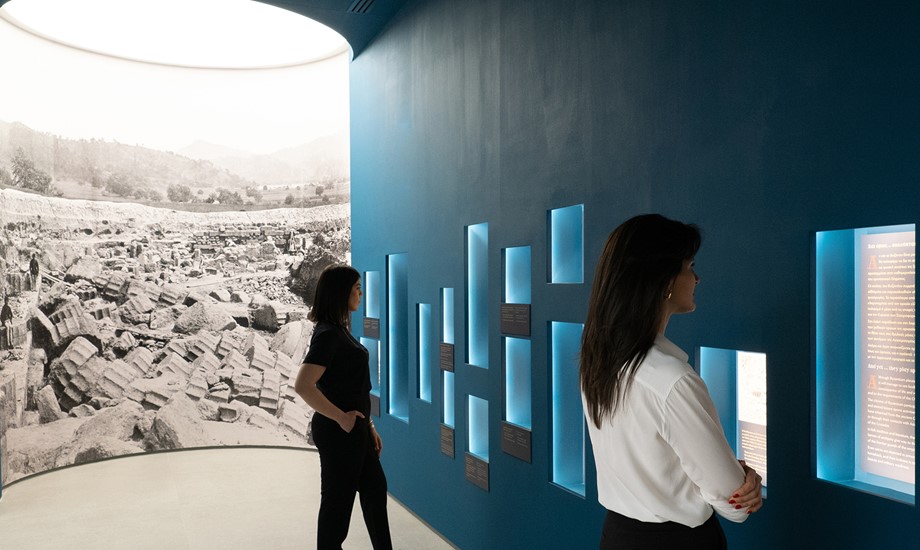A brief History of the Museum

The history of the Museum’s creation
The Olympic Games from Antiquity to date; the spirit of fair play as a universal value; Greece’s critical role in promoting Olympism and Athens’ promotion as an Olympic Capital; paying tribute to Greek athletes and presenting the Greek Olympic and Paralympic Champions who have won medals. These are the basic imperatives for the foundation of the Athens Olympic Museum, together with offering an unprecedented experience to the visitors, an idea that was born during the 2004 period.
Based on the above rationale, the Athens Olympic Museum was designed and implemented by Lamda Development S.A. according to international standards. The Museum operates under the aegis of the International Olympic Committee and the Hellenic Olympic Committee and is member of the International Olympic Museums Network.
In order to document the exhibits, the museum team has cooperated with over 40 national and international cultural bodies. These include top international museums such as the British Museum, the Metropolitan Museum of Art of New York City (Met), the State Hermitage Museum in Saint Petersburg, the National Archaeological Museum of Naples (Museo Archeologico Nazionale di Napoli) and the Bavarian State Archaeological Collection in Munich (Staatliche Antikensammlungen München), and Greek museums such as the Archaeological Museum of Olympia, the Benaki Museum, the Hellenic Literary and Historical Archive, etc.
Parallel to that, the donors’ contribution was invaluable, starting from the Greek Olympic and Paralympic Champions who offered medals and personal equipment (Pyrros Dimas, Spyros Gianniotis, Sofia Bekatorou, Emilia Tsoulfa, Leonidas Kokkas, Petros Galaktopoulos, Dimitris Mougios, Dimosthenis Tampakos, etc.). The same goes for members of the Olympic Family (Spyros Kapralos, Artemis Ignatiou), private collectors and donors (Pavlos Geroulanos, Kaftantzoglou family), as well as collections (Alpha Bank Numismatic Collection, Hellenic Post Philatelic Management).
In construction terms, the overall architectural approach and building philosophy of the Athens Olympic Museum has been designed so as to be worthy of promoting the culture and history of the Olympic Games, while at the same time it is fully compatible with modern environmental requirements. It is also linked to the Olympic Athletic Center of Athens "Spiros Louis” (OAKA) with a footbridge, thus giving the visitor another opportunity to live a special experience, traveling back in time to the 28th Olympiad, the 2004 Athens Olympic Games.

Contributors
Content, exhibition narrative and texts developed by Alexandra Nikiforidou and Georgia Panselina, Katerina Servi, Dr. Vasiliki Tzachrista, Vassia Pierrou. Architectural and exhibition design development by KLAB architecture & MULO creative lab. The design teams were Konstantinos Labrinopoulos, Xara Marantidou, Evangelia Kakava, Fani Peroni Chalkia, Katerina Tsitsiva and Vasiliki Dermitzaki. Klab collaborated with Cool Shadow for the lighting design. Xara Marantidou was responsible for the art direction of the exhibition. The conception and the design of the Museum, the guidelines for museography and the consultancy regarding the implementation of the project were originated by Mrs. Stavroula Vavalea. Professor Konstantinos Georgiadis acted as a consultant for content research & development. Videos produced by Filmosophy, with Katia Papanikola and Anna Papanikola and by Topcut Modiano with Kelly Alchanati Papouli. DTMH, Tom Kolokythas and Michalis Theodorakis developed the interactive digital systems. Translations and copy-editing of texts were done by Stephen Bacigal, Fotini Pipi and Sotiris Lappas. Original scores for the videos were composed by Evanthia Reboutsika. Ceramic replicas made by Thomas Kotsiyiannis. All other replicas made by Michalis Lagouvardos. Ilias Papageorgiou, Pantelis Feleris, Foivos Papageorgiou, Maria Kontaki, Giota Apostolou, and Vasilis Mentoyiannis were responsible for the conservation and installation of authentic objects. Emmanuel Lignos constructed the display cases and the Apolyto Creative Spot provided the digital prints. Specifications for the implementation of audiovisual applications provided by Gerasimos Efthymiatos & Co. and AV equipment provided by Omikron Electronics.



